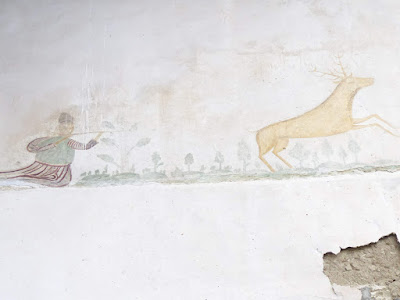We had a very busy day ahead of us and although it had stopped raining, it was still too cloudy to take advantage of the view from my lovely hotel room.
Anyway, our first visit this morning was through the old communist industrial area of the town where some of the factories are still being used by co-operatives.
 Our guide told us this was a pasta making factory and is still in use. being so close to Italy, pasta featured on many menus.
Our guide told us this was a pasta making factory and is still in use. being so close to Italy, pasta featured on many menus.
We visited a jam making industry. They only use local produce that is in season, which is all you will get in the restaurants as they do not import fruit and veg from around the world unlike we do in the UK. Hence the food is so fresh and delicious here. They were in between seasons at the factory. All the soft fruits had finished and they were now awaiting the oranges as their next main crop.
There were vats of figs and walnuts which were being softened, soon to be turned into jams.
We tasted fig, walnut, cherry, watermelon, quince and even grape jams. All of which were delicious.
I enjoyed viewing the town from this height. This is the Albanian flag flying from the top.
Every garden was full of fruit and veg.
Pomegranates were everywhere and I picked one off a tree which I later peeled and ate. It was so juicy and sweet.
From there we went to the town of Gjirokastra where we were spending the night. After dropping off our luggage we walked to the top of the hill for a tour of the castle. It was an impressive castle with great views of the town.
The clock tower was built under the rule of Ali Pasha in the early 19th century. According to legend, its bell could be heard as far away as Ioannina in northern Greece. However it was the next place we visited that was the most interesting.
Original wall paintings could still be seen both inside and outside the building. (Photos were not allowed of the inside.)
We just about managed to see it all before darknesss fell. After such a huge lunch we didn't want dinner but picked up a small pastry type of cheese sandwich in the bazaar. We wandered around and found our way to a hotel near the top of the hill where we could look down on the lights of the town and enjoyed a very nice gin and tonic.



























I too would have a secure basement under the house - to shelter in case of earthquakes, but also if rockets start flying overhead. However a men's-only pleasure room is too much to swallow.
ReplyDeleteI find your trip fascinating. It is another world, but lovely.
ReplyDeleteThe jam tasting looks fun. The city stone is quite impressive.
ReplyDeleteWhether it might be a good thing or a bad thing I don't know but Albania will change in time from being what we may think of as 'idyllic' to a much more western lifestyle. Young people can easily see a big wide world out there now and they won't be content with a small farm/village lifestyle. It is quite sad to contemplate.
ReplyDeleteBeautiful blog
ReplyDeleteSome interesting places. You can see how isolated this country was and still is in many respects.
ReplyDeleteFor some reason I am having trouble leaving comments on your blog!
ReplyDeleteJust to say I have been reading all of your posts about Albania ... quite fascinating, thank you.
What a traveller you are :)
All the best Jan
Success, my comment came through ... hope it stays ok and doesn't suddenly disappear!
ReplyDeleteTake care
All the best Jan
Your pictures remind me the little cities in the Eastern countries, the communists have left their traces !
ReplyDeleteWish we had that sort of history here but I love how the retailers buy local produce, that benefits everyone all around.
ReplyDeleteIt's wonderful that Albania has retained so much of their traditional farming techniques, so much better than our now mostly ruined farming and the resulting import of food. Many foods that we could and should grow ourselves. I think I would enjoy Albania despite its tarnished image from some years ago which I think is now forgotten. Did you change your camera?
ReplyDeleteIt's so interesting to learn about the small farms and the fact that they stayed that way after the end of Communist occupation; and quite wonderful to learn about how they really and truly "eat local" even in the restaurants.
ReplyDeleteThose rocky views are quite a sight.
ReplyDelete